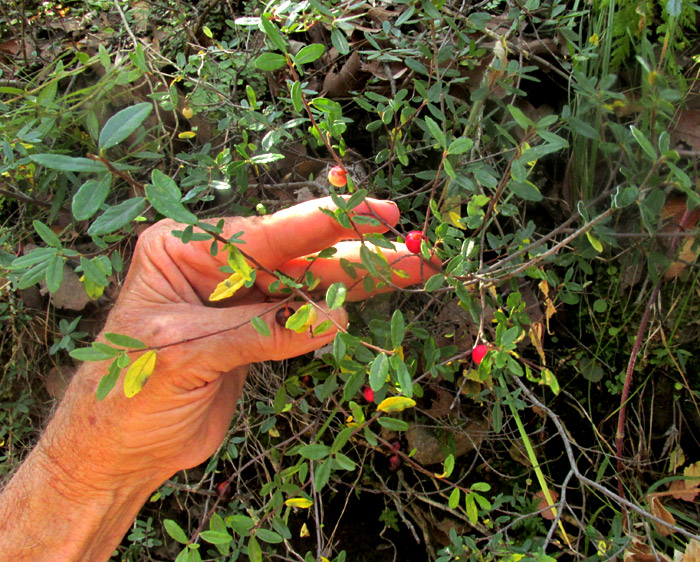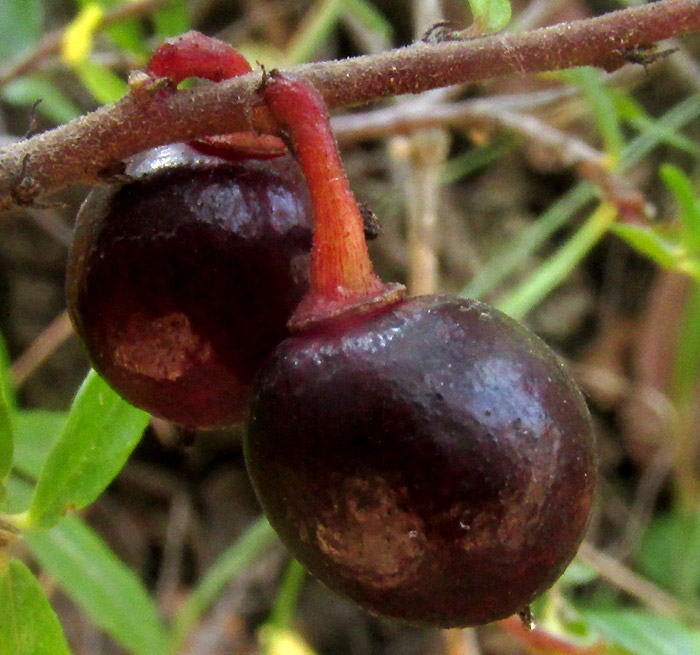Excerpts from Jim Conrad's
Naturalist Newsletter
Entry dated November 7, 2023, from notes taken at Cascadas de La Piedad waterfall 3kms NW of the community of San Pablo, municipality of Almeaco de Bonfil; bedrock of thick layers of compacted volcanic ash, or tuff; N20.1024°, W100.0019°, elevation 2360 meters (7750ft); extreme southern Querétaro state, MÉXICO
FRANGULA MICROPHYLLA

Roots of the above spindly, woody bush helped secure a dirt ledge overhanging a washout in an erosional gully in a hillside oak forest. The bush caught my attention with its red fruits, though a closer look found that mature fruits turned black:

Usually, but not always, identifying first-time encountered plants is heavily dependent on flower structure, so a flowerless bush showing no particularly unusual vegetative features can be hard to name. I hadn't even planned to photograph the bush, until a dissected fruit exposed what's seen below:

The fruit was divided into two chambers, or carpels, and each carpel contained one seed. That's somewhat of an unusual combination, which gave hope that identification would be possible.

The leaves were small with modest hints of crenulations along their margins, and arose from short petioles with slender stipules at their bases.

On leaf undersurfaces, yellowish midveins developed dark green secondary veins.
I found it hard to identify this bush. One reason was that the two seeds occupying our fruit in the photo weren't really seeds, and using technical literature for identification requires accurate use of terminology. Our "seeds" were to be considered "stones," like the stone of a peach fruit. If you crack open the hard, wrinkled surface of a peach fruit's stone, the soft, almond-like thing inside is the actual seed.
Still, after slogging through the genera and species of several possible plant families, a match for our bush was found in the Buckthorn Family, the Rhamnaceae.
In the 1996 treatment of the Rhamnaceae in the Flora del Bajío, our plant with its lack of tendrils, one exceptionally small leaf per stem node, and a fleshy fruit containing two seedlike stones, revealed itself as Rhamnus microphylla. However, nowadays that species has been shifted to the genus Frangula, so our plant is FRANGULA MICROPHYLLA.
Frangula microphylla is described as inhabiting highland forests of oak and pine. It's endemic just to Mexico, from the northwestern state of Durango south to Tlaxcala state in central Mexico. Judging from documented encounters, within its limited distribution it's uncommon but not really rare.
I find no mention of this species' human uses, though it's contribution to retarding further erosion in a gully would be considered useful to some. Also, its fleshy fruits surely are browsed by wildlife.